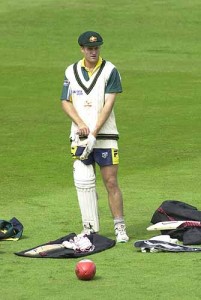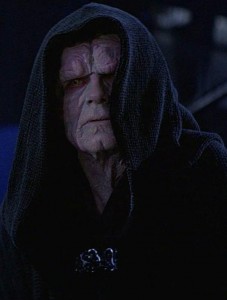
A gradual but inevitable descent into cricket-based loathing and bile.
Rage, Rage Against The Dying Of The Light: The Simon Katich Story
Way back in the dim dark days of mid June last year, when 51allout was still just finding its feet in the cut-throat world of online cricket blogs, those brave pioneers who guided her first steps gathered around to watch in awed silence as Australian cricket publicly tore itself to shreds. The media conference that Simon Katich gave that day seemed to reveal a sport irredeemably divided upon itself. Of players against players, and players against the administration. Whilst Cricket Australia has been able to fairly successfully put the humiliation of the drawn out internal Argus investigation behind it, it would have regarded Katich’s recent retirement (although he will continue to be available for County Cricket) with a decided sense of relief. For no player, not even Shane Warne, has generated the sort of controversy that Simon Katich did.
It is more than a little strange that Katich lived out much of his career in the media’s eye. His style of batting could hardly be described as flamboyant. His stance at the crease, whilst not as exaggerated as Shivnarine Chanderpaul’s, certainly mirrored the West Indian’s approach of presenting as open a face as possible and employing a limited number of straight bat shots to great effect. It is likewise impossible to refer to Katich’s character without reverting to such stock standard phrases as ‘gritty’ and ‘combative’. Much like Steve Waugh before him he hardly sought publicity, but when given the chance he proved to be (for an Aussie cricketer at least) both erudite and self-effacing. A player who, in a similar vein to Justin Langer, seemed to relish the danger inherent in close-in fielding positions, Katich was also a more than useful bowler, whose left arm Chinamen were frequently (criminally) overlooked by Ricky Ponting.
From his First Class debut in the mid 90’s Katich consistently compiled runs in Shield cricket year on year, without ever seemingly concerning the national selectors. He was called up to make his Test debut in Leeds, 2001 (a game famous for Mark Butcher’s epic second innings 173*) as an injury replacement for Steve Waugh, but after being subsequently dropped he switched the following season from his native West Australia to NSW. The move proved to be the catalyst for his rise for, as many of its detractors would argue, as far as the selectors are concerned runs scored for NSW seem to count double compared to those scored for the other states. The media hit on Katich as an unfairly overlooked batsman whose time had finally come, and he was championed in the Sydney press as the solution to the Test team’s middle order woes. Katich returned to the Test fold in the southern summer of 2003, firstly against Zimbabwe, then in the famous 2003/4 Indian tour that heralded Steve Waugh’s last hurrah. He quickly established himself in the side, averaging 63 in his first year back in the team, and 46 in the second.
Then came the Ashes tour of 2005 and everything went terribly, terribly, wrong. Katich seemed to lose all idea of where his off stump (or indeed any of his stumps) was and spent the tour tamely offering chance after chance into the slips, ending the series with an average of 27. A player who was supposed to have replaced Steve Waugh’s steely presence in the middle order instead proved to be a liability. Katich was made a public scapegoat for the team’s poor performance and the media turned its back on its former darling. He lasted the two Test series against the ICC World XI that followed, but a failure in the following game against the West Indies sealed his fate. At 30 years of age prospects of Katich returning to the Test team for a third time seemed dim.
As the Australian team focused on recovering the urn, which they did in memorable style in a series in 2006/7 that some here at 51allout still refuse to acknowledge ever actually occurred, Katich returned to domestic cricket, intent on rebuilding his game. In his first full season back in 2006/7 he showed that his batting demons were behind him as he averaged 64.6 opening for NSW. The following season, however, was a revelation, as he compiled 1,506 runs in 17 innings, at an average of 94.12, carrying NSW to the title. The Bradman comparisons were predictably not long in coming and Katich suddenly emerged as the player most capable of filling the hole left at the top of the Australian order by the retirement of Matthew Hayden.
Katich made his return in a low-key affair at the top of the Australian order alongside Phil Jaques in the tour of the West Indies in 2008. After a poor first Test he scored centuries in the following two and his position was secured. Katich would go on to average 56 for the calender year as an opening batsmen and during the next he averaged 48. The 2009 Ashes series proved to be a difficult time though. Although nowhere near as bad as the nightmare tour he suffered in 2005, a century in the opening Cardiff Test proved to be his only real contribution of note as he passed fifty on only one other occasion in the series. As Phil Hughes, his opening partner, was mercilessly (or humorously, depending on your perspective) hounded by the English attack before being hung out to dry by the Australian selectors, Katich failed to provide the stability that was required at the top of the order. He didn’t suffer a bad series by any means, but it was hardly the redemption that he would have been hoping for on English soil.
However Katich’s performances elsewhere were strong, and he had a dominant domestic season against the West Indies, Pakistan and New Zealand. Going into the 2010/11 Ashes he was Australia’s best performing batsman, and the lynchpin of their campaign to wrest back control of the urn. In the Gabba Test, after a torrid first half hour where he was thoroughly worked over by James Anderson, he compiled a patient half century before giving Steve Finn his first Ashes wicket with a sharply taken return catch. An achilles injury suffered in the field hampered his batting in the second innings, and after missing the next Test, the injury flared up again on the third day of the Adelaide Test, leading to doubts he would be able to bat at all in the second innings. In a injury restricted innings he compiled 43 before falling to Swann and ultimately missed the rest of the series. It would prove to be his final Test appearance.
The decision to cut Katich from Cricket Australia’s list of contracted players in June 2011 came as a bombshell. Since his return in 2008 Katich had scored 2,928 runs, behind only Alastair Cook in Test cricket over this period, at an average of 50.48. That Katich could be cut when the under-performing, and older, Ricky Ponting was not created a furore that his incendiary press conference did little to calm. While Katich did not immediately give up hope of a return, he later expressed his belief that a dressing room altercation between himself and Michael Clarke, after a victory over South Africa in 2009, had played a part in his axing, whilst Clarke’s new role as both captain and selector effectively ended any chance of re-selection. The acrimony created by that incident still lingers, although the decision taken by Cricket Australia to stand behind its nominated future Test captain has been somewhat vindicated by Michael Clarke’s impressive first season in charge.
Nearly a year on from Katich’s sensational axing it is still hard to say whether Cricket Australia made the correct decision or not. The nature of his departure, the heartfelt manner in which he expressed himself during the accompanying press conference and the less than impressive performance of his replacements, first Phil Hughes then Ed Cowan, have only served to increase public affection for the discarded opener. Whilst the sheer number of runs he scored in Test cricket after his return is testament to his quality, his average of 31 against England, Australia’s main competition during this period, was a poor return. It is possible, as it’s sometimes suggested, that Katich was cut adrift in order that Clarke could better be eased into the role of captain. Even if that’s not true, it’s hard to escape the feeling that politics played a role in his exclusion. If so, it was a sad and unfitting end to the career of fine player who, if anything, was guilty only of allowing his intense drive to succeed on the pitch to impact on his off-field relationships.





2 Comments
Post a Comment
1
51allout » Whatever Happened To The Unlikely Lads? International Edition #23: Shaun Marsh
22 Dec 2012 12:27
[…] Test cricket, though, seems beyond him now. He has too many black marks against his name, and the Simon Katich Law dictates that he should give up on that idea now, if indeed he hasn’t already. There’s […]
2
Matt H
16 Jun 2012 14:28
One wonders if his average against England would have been significantly better if he’d played the 06/07 series. If it even existed.